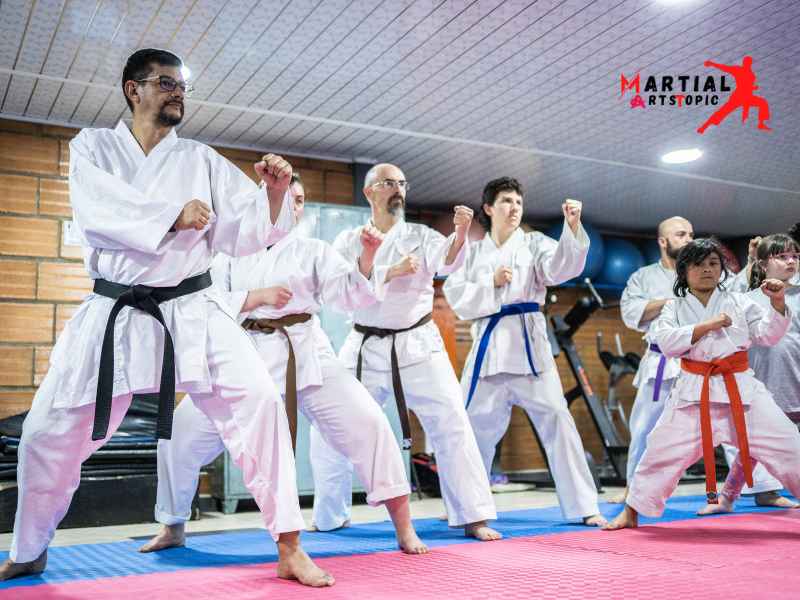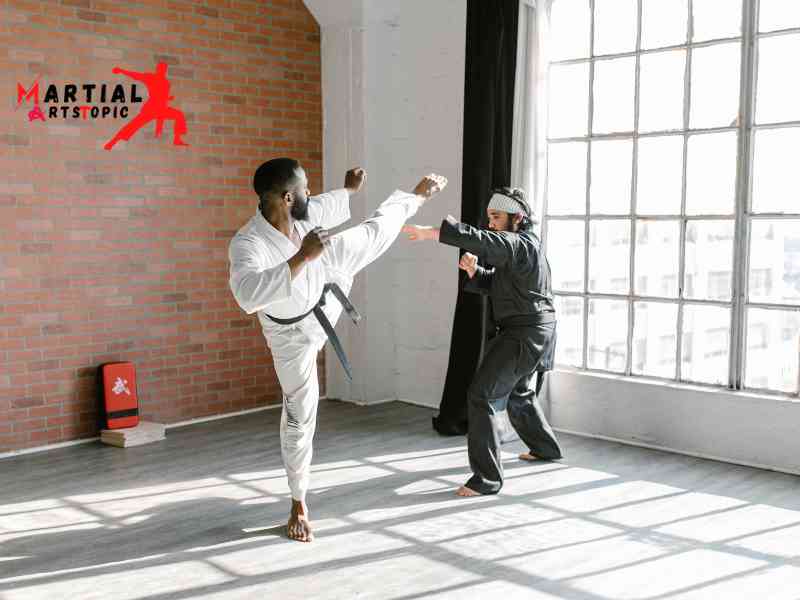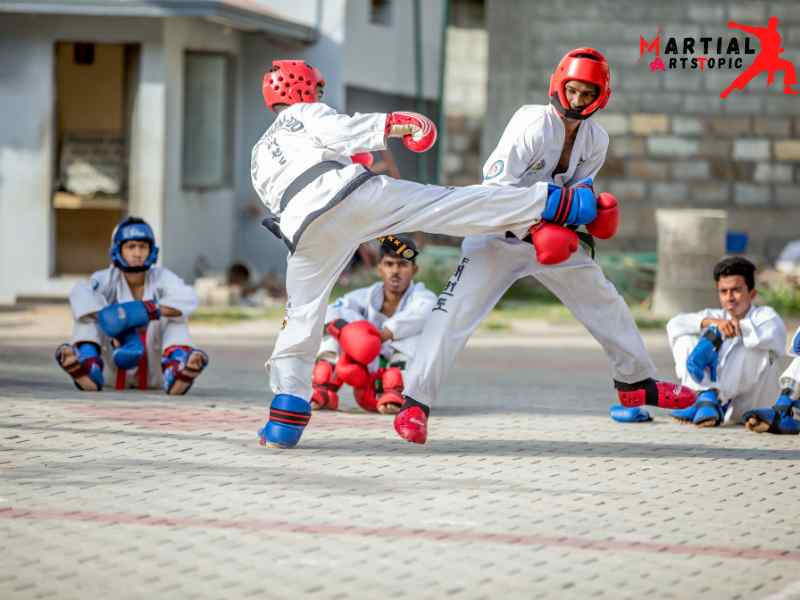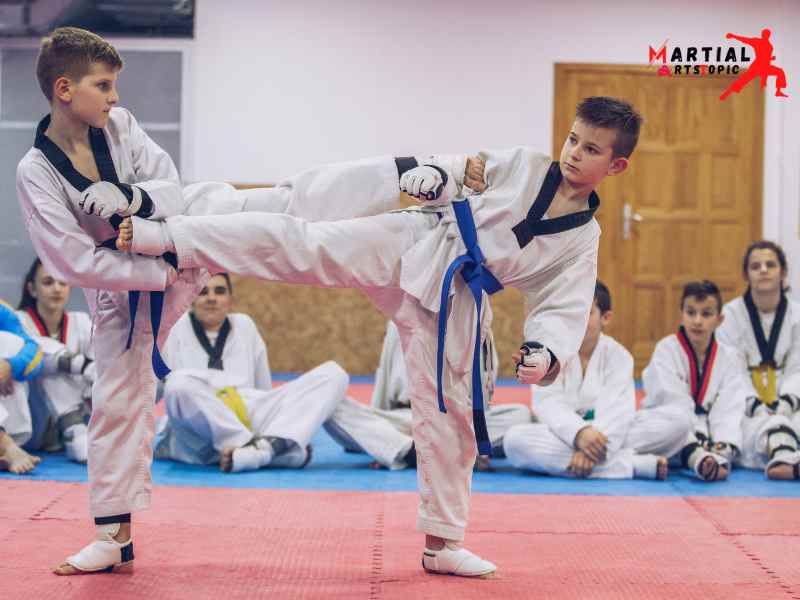
The History and Origins of Kumite Karate
The History and Origins of Kumite Karate: Kumite karate, a dynamic and exhilarating martial art, has gained immense popularity worldwide for its unique blend of technique, discipline, and physical prowess. But have you ever wondered about the origins and rich history behind this fascinating combat sport? Join us on a journey as we uncover the roots of kumite karate, exploring its origins, development, and evolution over the centuries.
Origins of Kumite Karate: Tracing Back in Time
To understand the origins of kumite karate, we must delve deep into the annals of history. The birthplace of this martial art can be traced back to the island of Okinawa, a small but significant part of Japan. Okinawa, historically known as the Ryukyu Kingdom, was a melting pot of cultural exchange, where various martial arts styles from China and Japan intermingled and influenced each other.
In the early days, kumite karate was not a formalized martial art but self-defense used by the Okinawan people to protect themselves from bandits and other threats. It was during this time that the foundations of kumite karate, emphasizing effective strikes, blocks, and footwork, were laid.
Development and Evolution: From Okinawa to the World

As Okinawa’s contacts with China and Japan grew, so did the art of kumite karate. Influenced by Chinese martial arts such as Fujian White Crane and Shaolin Kung Fu, as well as Japanese martial arts like Jujutsu, kumite karate began to take shape as a distinct and refined martial art.
In the early 20th century, Gichin Funakoshi, often referred to as the father of modern karate, introduced kumite karate to mainland Japan. Funakoshi’s efforts to popularize karate in Japan led to the establishment of the Japan Karate Association (JKA) and the formalization of kumite karate as a sport.
From Japan, kumite karate spread internationally, captivating enthusiasts around the world with its dynamic techniques and intense sparring matches. Today, it is an integral part of many martial arts competitions and has even been featured in prestigious events like the Olympics.
The Essence of Kumite Karate: Discipline and Technique
Central to the practice of kumite karate is the concept of discipline and the development of proper technique. Practitioners of kumite karate undergo rigorous training, honing their physical strength, agility, and mental focus. The aim is not only to master the techniques, but also to cultivate a sense of respect, humility, and self-control.
Its intense and controlled sparring matches, where practitioners apply their techniques in real-time combat situations characterized Kumite karate. These matches showcase the practitioner’s speed, precision, and strategic thinking, making kumite karate an exhilarating spectator sport.
The Future of Kumite Karate: A Global Phenomenon
As kumite karate continues to captivate audiences and practitioners worldwide, its future looks promising. With the recent inclusion of karate in the Olympic Games, kumite karate has gained even more recognition, attracting a new generation of enthusiasts eager to experience the beauty and power of this ancient martial art.
Unveiling the Secrets: Basic Techniques in Kumite Karate
Unveiling the Secrets: Basic Techniques in Kumite Karate, a martial art originating from Okinawa, Japan, has gained immense popularity worldwide. Known for its powerful strikes and swift movements, karate practitioners engage in various forms of training to enhance their skills. One of the most dynamic and exciting aspects of karate is Kumite, sparring that allows practitioners to put their techniques into practice in a controlled environment. In this blog post, we will dive into the secrets behind Kumite Karate, exploring the basic techniques that every aspiring karateka should know.
Stances and Footwork
Stances are the foundation of any martial art, and Kumite Karate is no exception. The correct posture and footwork are crucial for maintaining balance, stability, and agility during sparring. Some common stances used in Kumite Karate include the front stance (zenkutsu-dachi), back stance (kokutsu-dachi), and horse stance (kiba-dachi). Mastering these stances allows karate practitioners to generate power and execute techniques effectively.
Blocks and Strikes
Kumite Karate involves both defensive and offensive techniques. Blocks are used to defend against incoming attacks, while it employed strikes to counter-attack and score points. Some essential blocks in Kumite Karate include the rising block (age uke), inward block (uchi uke), and outward block (soto uke). On the other hand, strikes like punches, kicks, and knee strikes are utilized to overwhelm opponents and gain an advantage in the sparring match.
Timing and Distance Control
Timing and distance control are vital elements of Kumite Karate. Proper timing allows karate practitioners to exploit their opponent’s weaknesses and launch effective counter-attacks. Understanding the concept of maai (distance) is crucial, as it enables practitioners to maintain a safe distance while still being able to strike effectively. By mastering timing and distance, karateka can anticipate their opponent’s movements and execute techniques with precision.
Combination Techniques
Combination techniques involve chaining together multiple strikes, blocks, and footwork seamlessly. These combinations can confuse opponents and create openings for successful attacks. By practicing various combinations, karate practitioners can enhance their fluidity, speed, and accuracy in Kumite Karate. Some popular combination techniques include jab-cross-hook, roundhouse kick-follow-up punch, and front kick-spinning back kick.
Body Movement and Feints
Body movement plays a significant role in Kumite Karate. By incorporating feints and deceptive movements, karateka can mislead their opponents and create opportunities for successful strikes. Techniques such as side steps, hip rotations, and sudden changes in direction can confuse and destabilize opponents, allowing karate practitioners to gain the upper hand in sparring matches.
If you are interested in learning more about Kumite Karate or seeking professional guidance, we recommend joining a reputable karate dojo or training under the supervision of a qualified instructor. Happy training and may your Kumite Karate journey be filled with success and fulfillment!
Kumite Karate Rules and Safety Guidelines

What is Kumite Karate? Unveiling the Rules and Safety Guidelines When it comes to martial arts, few disciplines are as thrilling and action-packed as Kumite Karate. This dynamic style of karate focuses on sparring and combat, allowing practitioners to showcase their skills, speed, and precision. But like any contact sport, Kumite Karate has its own set of rules and safety guidelines to ensure the well-being of participants. In this blog post, we will explore the ins and outs of Kumite Karate and provide you with a comprehensive understanding of the rules and safety precautions involved.
Kumite Karate Rules: The Path to Victory
In Kumite Karate, the rules serve as a framework for fair and controlled combat. These rules are designed to promote safety while still allowing participants to unleash their full potential. Here are some of the key rules that govern Kumite Karate matches:
- Weight Classes: To ensure fairness and safety, they usually divide participants into weight classes. This ensures that opponents are evenly matched in terms of size and strength.
- Protective Gear: Safety is of utmost importance in Kumite Karate. Competitors must wear appropriate protective gear, including mouth guards, hand pads, foot pads, and groin protectors. These protective measures help minimize the risk of injury.
- Points System: they usually score Kumite Karate matches based on a points system. Strikes to specific target areas, such as the head, torso, or side, are awarded varying points. Techniques executed with precision and control are highly valued.
- Time Limits: They typically held matches within a specified time limit, ensuring that bouts do not drag on indefinitely. This adds an element of urgency and intensity to the matches, encouraging participants to strategize and execute their moves efficiently.
- Fouls and Penalties: They strictly prohibited certain actions in Kumite Karate. These include striking below the belt, attacking the back of the head, executing excessive force, or engaging in unsportsmanlike behavior. Violations result in penalties, which can lead to disqualification.
Safety Guidelines: Protecting Participants from Harm
While Kumite Karate is an exhilarating sport, safety is paramount. To ensure the well-being of participants, they must follow certain safety guidelines. Here are some essential safety precautions to consider:
- Proper Warm-up: Before engaging in Kumite Karate, participants should always warm up their muscles and joints. This helps prevent injuries and prepares the body for the physical demands of the sport.
- Controlled Techniques: Kumite Karate emphasizes control and precision. Participants must execute their strikes with control, ensuring they do not cause unnecessary harm to their opponents.
- Respect for Opponents: Respect is a fundamental aspect of Kumite Karate. Participants should always treat their opponents with respect and adhere to the principles of fair play. Unsportsmanlike behavior, such as taunting or excessive aggression, is strongly discouraged.
- Regular Training and conditioning: Regular training and conditioning are essential for participants to build strength, flexibility, and endurance. This helps reduce the risk of injuries and enhances overall performance.
- Qualified Instructors: It is crucial to train under the guidance of qualified instructors who prioritize safety and provide proper instruction for Kumite Karate techniques. They can ensure that participants learn the correct form and execution of moves while emphasizing safety protocols.
Kumite Karate: Essential Tips and Techniques for Success
Kumite Karate: Essential Tips and Techniques for Succes sif you are passionate about martial arts, specifically kumite karate, then you’ve come to the right place. The essential tips and techniques that will help you master the art of kumite karate. Whether you’re a beginner or an experienced practitioner, these insights will elevate your skills to new heights. Let’s get started!
- Understanding Kumite Karate: Before diving into the tips and techniques, it’s crucial to understand the fundamentals of kumite karate. Kumite is sparring in karate that focuses on applying techniques against an opponent in a controlled environment. It requires a combination of speed, strength, agility, and mental fortitude.
- Develop Strong Basics: Just like any other martial art, mastering the basics is essential in kumite karate. Spend ample time practicing stances, punches, kicks, and blocks. This foundation will serve as a solid platform for your progress in kumite.
- Focus on Speed and Accuracy: Kumite karate demands quick reflexes and precise movements. Train yourself to be swift and accurate in executing techniques. They can achieve this through regular practice, drills, and shadowboxing.
- Sharpen Your Footwork: Excellent footwork is crucial for effective kumite. Work on your agility and balance by incorporating footwork exercises into your training routine. This will help you maintain proper distance from your opponent and execute techniques with precision.
- Master the Art of Timing: Kumite karate is all about timing. Learn to anticipate your opponent’s moves and strike at the right moment. This requires keen observation, focus, and practice. Take the time to study your opponent’s patterns and develop strategies accordingly.
- Enhance Your Reaction Time: Reacting swiftly to your opponent’s attacks is vital in kumite karate. Improve your reaction time by engaging in partner drills and sparring sessions. This will train your body to respond instinctively and effectively.
- Utilize Proper Breathing Techniques Breathing plays a significant role in kumite karate. Practice deep diaphragmatic breathing to increase your lung capacity and oxygen intake. This will help you maintain focus, endurance, and control throughout your sparring sessions.
- Train Both Offensive and Defensive Techniques: A well-rounded kumite karate practitioner should excel in both offense and defense. Practice a variety of offensive techniques like punches, kicks, and strikes, along with defensive moves such as blocks and evasive maneuvers. This balance will make you a formidable opponent.
- Improve Your Conditioning: Kumite karate can be physically demanding, so it’s essential to be in top shape. Incorporate strength training, cardiovascular exercises, and flexibility training into your routine. This will enhance your overall performance and prevent injuries.
- Seek Guidance from Experts: To truly main kumite karate, seek guidance from experienced instructors or trainers. They can provide valuable feedback, correct your technique, and offer personalized training plans. Learning from experts will fast-track your progress and ensure you’re on the right path.
Kumite Karate: The Evolution of Traditional Martial Arts
Kumite Karate: The Evolution of Traditional Martial Arts In the realm of martial arts, few disciplines have captured the imagination and awe quite like Kumite Karate. Originating from traditional Japanese martial arts, Kumite Karate has evolved over the years, blending ancient techniques with modern training methods. This unique fusion has made Kumite Karate a force to be reckoned with in the world of martial arts.
What is Kumite Karate?
What is Kumite Karate? Kumite Karate is a form of sparring that focuses on practical application. Derived from the Japanese words “kumi” (meaning “grappling”) and “te” (meaning “hand”), Kumite Karate emphasizes close combat techniques and the use of strikes, kicks, and throws. It is a dynamic and fast-paced form of martial arts that requires quick reflexes, precision, and mental agility.
The Evolution of Kumite Karate
Kumite Karate has come a long way since its inception. Originally developed as a means of self-defense, it has developed into a full-fledged competitive sport. Traditional martial arts techniques have been refined and adapted to suit modern training methods, making Kumite Karate an effective martial art form.
In the early days, something primarily practiced Kumite Karate within the confines of traditional dojos (training halls). However, with the rise of mixed martial arts (MMA) and the increasing popularity of combat sports, Kumite Karate has gained recognition and has found its place in the mainstream.
Training in Kumite Karate

Training in Kumite Karate is intense and demanding. Practitioners undergo rigorous physical conditioning to develop strength, speed, and endurance. They also focus on mastering various striking and grappling techniques, as well as honing their defensive skills.
Sparring sessions play a crucial role in Kumite Karate training. Practitioners engage in controlled combat scenarios to simulate real-life situations. This helps them develop the ability to think quickly, react instinctively, and execute techniques with precision.
Benefits of Kumite Karate
Kumite Karate offers a wide range of benefits, both physical and mental. Here are a few key advantages of practicing Kumite Karate:
- Self-defense: Kumite Karate equips practitioners with practical self-defense skills, empowering them to protect themselves in real-life situations.
- Fitness and conditioning: The intense training involved in Kumite Karate improves cardiovascular health, builds strength and endurance, and enhances overall fitness levels.
- Discipline and focus: Kumite Karate instills discipline, focus, and mental fortitude. Practitioners learn to concentrate their minds and remain calm under pressure.
- Confidence and self-esteem: As practitioners progress in their Kumite Karate journey and master new techniques, their confidence and self-esteem grow. This newfound confidence often extends beyond the dojo and positively impacts other areas of life.
The Importance of Kumite Karate in Martial Arts Training
The Importance of Kumite Karate in Martial Arts Training When it comes to martial arts training, there are various disciplines that practitioners can choose from. One of the most popular and effective forms of martial arts is Kumite Karate. Kumite Karate, also known simply as Kumite, is a dynamic and intense form of karate that focuses on sparring and fighting techniques. In this blog post, we will explore the importance of Kumite Karate in martial arts training and how it can benefit practitioners.
Kumite Karate is a vital component of martial arts training because it allows practitioners to apply their techniques in a realistic and dynamic setting. Unlike other forms of karate that primarily focus on forms and katas, Kumite Karate emphasizes the practical application of techniques through controlled sparring matches. This not only helps practitioners develop their fighting skills, but also enhances their ability to react quickly and adapt to different situations.
One of the key benefits of Kumite Karate is its ability to improve physical fitness and conditioning. The rigorous training routines and intense sparring sessions in Kumite Karate help practitioners develop strength, endurance, and agility. The fast-paced nature of Kumite Karate requires practitioners to be constantly on their toes and engage in explosive movements, which helps improve cardiovascular health and overall fitness levels.
In addition to physical fitness, Kumite Karate also plays a crucial role in developing mental discipline and focus. The high-intensity sparring matches in Kumite Karate require practitioners to stay calm and composed under pressure, making split-second decisions while maintaining control. This not only enhances mental resilience but also improves concentration and focus, which can be applied to various aspects of life outside of martial arts.
Furthermore, Kumite Karate instills important values, such as respect, discipline, and perseverance among practitioners. The strict training routines and the emphasis on respect for opponents and instructors help cultivate a disciplined mindset. Additionally, the challenging nature of Kumite Karate pushes practitioners to persevere and overcome obstacles, teaching them valuable life lessons that can be applied beyond the dojo.
From a self-defense perspective, Kumite Karate equips practitioners with the necessary skills to protect themselves in real-life situations. The practical application of techniques in sparring matches helps practitioners become more confident in their ability to defend themselves effectively. The constant practice of Kumite Karate techniques also improves muscle memory, allowing practitioners to react instinctively in dangerous situations.
The Role of Kumite Karate in Competitive Martial Arts
The Role of Kumite Karate in Competitive Martial Arts When it comes to competitive martial arts, one style that stands out is Kumite Karate. Known for its intense and dynamic fighting techniques, Kumite Karate has become a popular choice for athletes looking to excel in the world of martial arts. In this blog post, we will explore the role of Kumite Karate in competitive martial arts and delve into why it is considered a valuable skill for any martial artist.
Kumite Karate, also known as “sparring” karate, is a crucial component of competitive martial arts. It involves controlled and regulated combat between two opponents, applying various striking and blocking techniques. The objective is to score points by executing precise techniques on specific target areas, such as the head or body. This intense form of combat requires speed, agility, and exceptional timing.
One of the key aspects that makes Kumite Karate unique is its emphasis on strategy and adaptability. Unlike other martial arts styles that focus more on predetermined forms and techniques, Kumite Karate encourages practitioners to think on their feet and react in real-time. It teaches athletes to analyze their opponents, anticipate their moves, and develop effective counterattacks. This ability to adapt quickly to changing situations is invaluable in competitive martial arts.
Kumite Karate fosters discipline and mental fortitude. Competitors must possess a strong mindset to overcome the physical demands and challenges they face on the mat. Mental clarity, focus, and the ability to remain calm under pressure are essential attributes of success in Kumite Karate. This mental strength translates not only to the sport but also to various other aspects of life.
In addition to its practical application in self-defense, Kumite Karate offers a range of physical benefits. Regular training in Kumite Karate improves cardiovascular fitness, enhances coordination and balance, and increases overall body strength. The rigorous training drills and conditioning exercises push athletes to their limits, resulting in improved stamina and endurance. These physical benefits are not only advantageous in Kumite Karate competitions but also in other sports and daily activities.
Kumite Karate also instills important values, such as respect, humility, and sportsmanship. The competitive nature of Kumite Karate requires participants to demonstrate respect towards their opponents, coaches, and officials. It teaches athletes to accept both victory and defeat graciously, promoting a healthy competitive spirit and fostering camaraderie among practitioners. These values are crucial in building character and shaping individuals into well-rounded martial artists.
In conclusion
What is Kumite Karate? kumite karate is a dynamic and intense form of martial arts that requires skill, discipline, and perseverance. Through rigorous training and sparring sessions, practitioners develop not only their physical strength and agility but also their mental focus and self-confidence. The competitive nature of kumite karate enables individuals to challenge themselves, push their limits, and strive for continuous improvement. Whether it is for self-defense purposes or as a sport, kumite karate offers a unique opportunity for personal growth and development. So, if you’re looking for a challenging and rewarding martial arts experience, kumite karate is definitely worth exploring.
